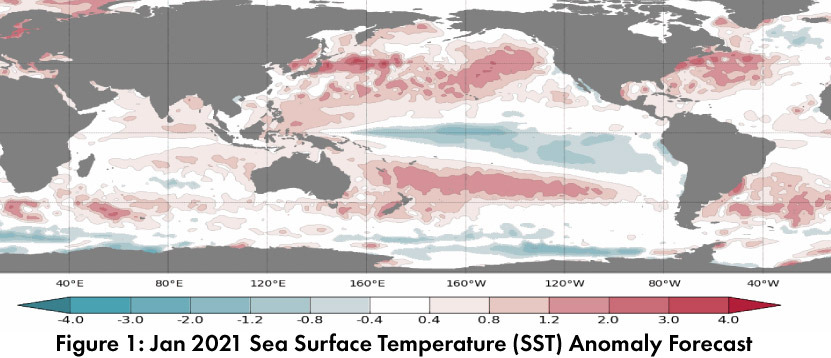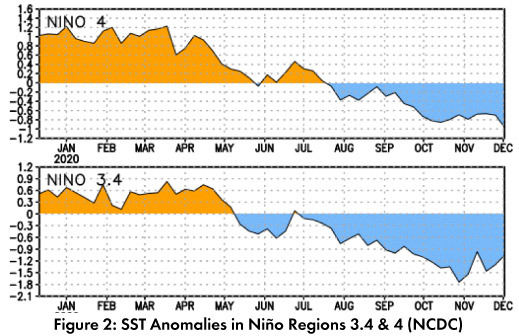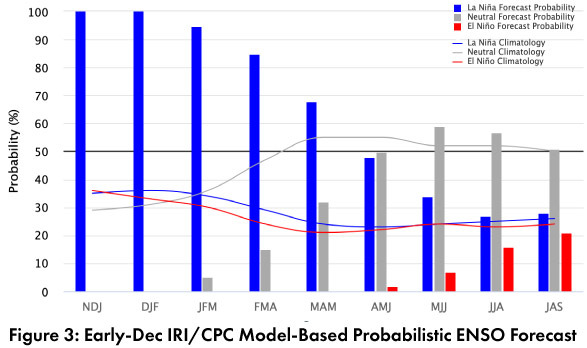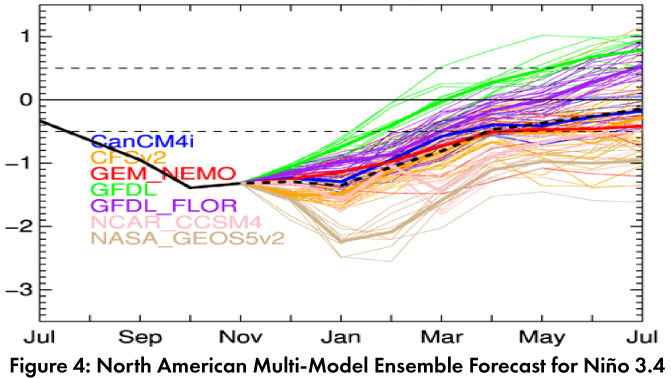Southwest Climate Outlook - El Niño Tracker - December 2020
Sea surface temperature (SST) forecasts for Jan 2021 are below normal across the equatorial Pacific (Fig. 1), extending the trend of the last 4-5 months (Fig. 2). Climate outlooks generally have La Niña conditions persisting through winter 2020-2021 before returning to normal conditions over spring 2021.


Forecast Roundup: On Dec 8, the Australian Bureau of Meteorology was at official La Niña status and noted: “oceanic and atmospheric conditions reflect a mature La Nina with little variation…(suggesting) the event will peak at moderate levels”. On Dec 10, the Japanese Meteorological Agency (JMA) maintained its forecast of a 90-percent chance of La Niña conditions through winter. On Dec 10, the NOAA Climate Prediction Center (CPC) ENSO status was at La Niña Advisory. The CPC called for a 95-percent chance of La Niña continuing through March and a 50-percent chance of transition to neutral during late spring or early summer. On Dec 10, the International Research Institute (IRI) issued an ENSO Quick Look (Fig. 3), noting “the east-central Pacific is roughly 1 degree C below average, and all key atmospheric variables are consistent with La Niña conditions”. The North American Multi-Model Ensemble (solid and dashed black line, Fig. 4) indicates moderate La Niña conditions for the next few months, with a shift to ENSO-neutral by late spring or early summer.


Summary: La Niña conditions are present and according to most ENSO forecasts and outlooks, they look to remain in place through winter or early spring. The monthly and seasonal climate outlooks suggest drier than normal conditions over winter. This would exacerbate the precipitation deficits already observed over the last six months (Jun-Nov): a period that was record driest for Arizona and second driest for New Mexico. The seasonal totals during La Niña events are often lower than average (see next page for detailed plots of cool-season precipitation). This of course does not mean zero precipitation will fall, but the likely outcome would be less frequent events and lower seasonal totals if the typical pattern for a La Niña winter pans out.
Online Resources
- Figures 1 - Australian Bureau of Meteorology - bom.gov.au/climate/enso
- Figure 2 - NOAA - Climate Prediction Center - cpc.ncep.noaa.gov
- Figure 3 - International Research Institute for Climate and Society - iri.columbia.edu
- Figure 4 - NOAA - Climate Prediction Center - cpc.ncep.noaa.gov

